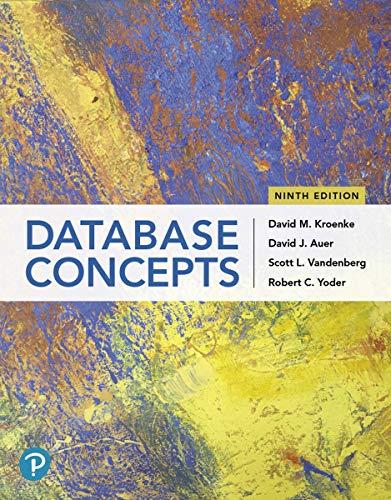Question
Please write the follwing Python program. Show all outputs. Mailroom A complete program Using basic data types and logic for a full program Goal: You
Please write the follwing Python program. Show all outputs.
Mailroom
A complete program
Using basic data types and logic for a full program
Goal:
You work in the mail room at a local charity. Part of your job is to write incredibly boring, repetitive emails thanking your donors for their generous gifts. You are tired of doing this over an over again, so youve decided to let Python help you out of a jam.
The program
Write a small command-line script called mailroom.py. This script should be executable. The script should accomplish the following goals:
It should have a data structure that holds a list of your donors and a history of the amounts they have donated. This structure should be populated at first with at least five donors, with between 1 and 3 donations each
The script should prompt the user (you) to choose from a menu of 3 actions: Send a Thank You or Create a Report or quit)
Sending a Thank You
If the user (you) selects Send a Thank You, prompt for a Full Name.
If the user types list, show them a list of the donor names and re-prompt
If the user types a name not in the list, add that name to the data structure and use it.
If the user types a name in the list, use it.
Once a name has been selected, prompt for a donation amount.
Turn the amount into a number it is OK at this point for the program to crash if someone types a bogus amount.
Once an amount has been given, add that amount to the donation history of the selected user.
Finally, use string formatting to compose an email thanking the donor for their generous donation. Print the email to the terminal and return to the original prompt.
It is fine to forget new donors once the script quits running.
Creating a Report
If the user (you) selected Create a Report print a list of your donors, sorted by total historical donation amount.
Include Donor Name, total donated, number of donations and average donation amount as values in each row. You do not need to print out all their donations, just the summary info.
Using string formatting, format the output rows as nicely as possible. The end result should be tabular (values in each column should align with those above and below)
After printing this report, return to the original prompt.
At any point, the user should be able to quit their current task and return to the original prompt.
From the original prompt, the user should be able to quit the script cleanly
Your report should look somethign like this:
Donor Name | Total Given | Num Gifts | Average Gift ------------------------------------------------------------------ William Gates, III $ 653784.49 2 $ 326892.24 Mark Zuckerberg $ 16396.10 3 $ 5465.37 Jeff Bezos $ 877.33 1 $ 877.33 Paul Allen $ 708.42 3 $ 236.14
Guidelines
First, factor your script into separate functions. Each of the above tasks can be accomplished by a series of steps. Write discreet functions that accomplish individual steps and call them.
Second, use loops to control the logical flow of your program. Interactive programs are a classic use-case for the while loop.
Of course, input() will be useful here.
Put the functions you write into the script at the top.
Put your main interaction into an if __name__ == '__main__' block.
Finally, use only functions and the basic Python data types youve learned about so far. There is no need to go any farther than that for this assignment.
Submission
As always, put the new file in your student directory in a session03 directory, and add it to your clone early. Make frequent commits with good, clear messages about what you are doing and why.
When you are done, push your changes and make a pull request.
Adding dicts...
For the next week (after Session04)
You should have been able to do all that with the basic data types:
numbers, strings, lists and tuples.
But once youve learned about dictionaries (Session04) you may be able to re-write it a bit more simply and efficiently.
Update mailroom from last week to:
Use dicts where appropriate
Write a full set of letters to everyone to individual files on disk
See if you can use a dict to switch between the users selections
Try to use a dict and the .format() method to do the letter as one big template rather than building up a big string in parts.
Example:
In [3]: d Out[3]: {'first_name': 'Chris', 'last_name': 'Barker'} In [5]: "My name is {first_name} {last_name}".format(**d) Out[5]: 'My name is Chris Barker' Dont worry too much about the ** well get into the details later, but for now, it means, more or less pass this whole dict in as a bunch of keyword arguments.
Adding Exceptions
After Session05:
Exceptions:
Now that youve learned about Exception handling, you can update your code to handle errors better like when a user inputs bad data.
Comprehensions:
Can you use comprehensions to clean up your code a bit?
Tests
Add some tests..
Step by Step Solution
There are 3 Steps involved in it
Step: 1

Get Instant Access to Expert-Tailored Solutions
See step-by-step solutions with expert insights and AI powered tools for academic success
Step: 2

Step: 3

Ace Your Homework with AI
Get the answers you need in no time with our AI-driven, step-by-step assistance
Get Started


